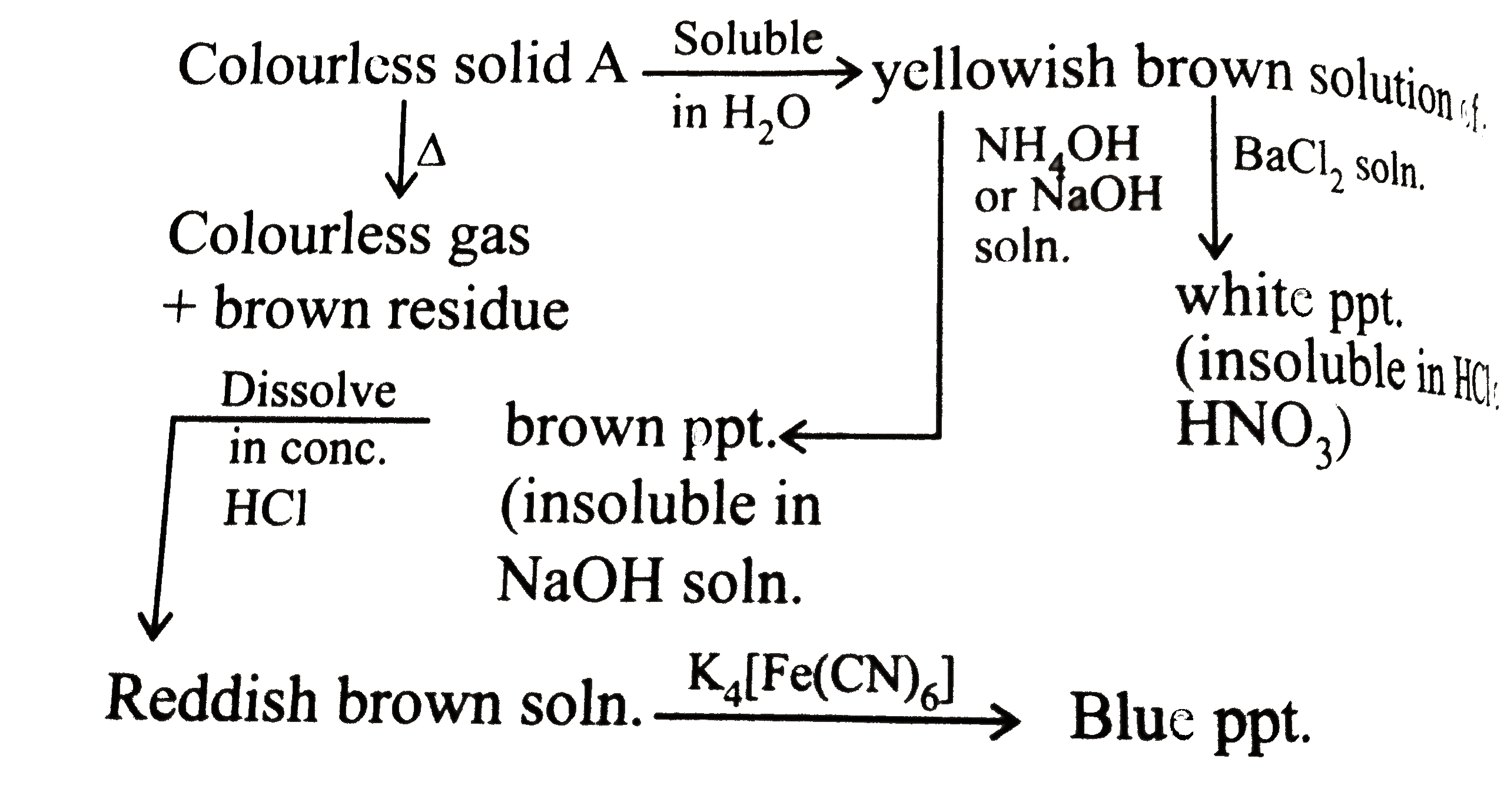Which of the following options are correct for [Fe(CN)6]3− complex ?
d2sp3 hybridisation
sp3d2 hybridisation
Paramagnetic
Diamagnetic
The correct Answer is:A, C
To determine the correct options for the complex (Fe(CN)6)3−, we will follow these steps:
Step 1: Determine the oxidation state of Iron (Fe)
The charge of the complex is −3. The cyanide ion (CN) has a charge of −1. Since there are 6 cyanide ions, their total contribution to the charge is 6×−1=−6.
Let the oxidation state of iron be x. The equation can be set up as follows:
x+6(−1)=−3
x−6=−3
x=+3
Step 2: Determine the electronic configuration of Iron in this oxidation state
Iron has an atomic number of 26, and its electron configuration is:
(Ar)3d64s2
When it loses 3 electrons to form Fe3+, the configuration becomes:
(Ar)3d5
Step 3: Analyze the ligand field
Cyanide (CN−) is a strong field ligand. Strong field ligands cause pairing of electrons in the lower energy d-orbitals (t2g) before occupying the higher energy orbitals (eg).
Step 4: Fill the d-orbitals
For Fe3+ with a 3d5 configuration in the presence of a strong field ligand, the electrons will pair up in the t2g orbitals. The filling will be as follows:
- The 5 electrons will occupy the t2g orbitals, resulting in:
- t2g: ↑↑↑↑↑ (5 electrons in t2g, no electrons in eg)
Step 5: Determine the hybridization
In an octahedral complex like (Fe(CN)6)3−, the hybridization can be determined by the number of orbitals involved in bonding. For this complex:
- 2 d-orbitals, 1 s-orbital, and 3 p-orbitals are used for hybridization.
Thus, the hybridization is:
d2sp3
Step 6: Determine magnetic properties
Since there is 1 unpaired electron in the t2g orbitals, the complex is paramagnetic.
Final Conclusion
Based on the analysis:
1. The hybridization is d2sp3 - True
2. The hybridization is sp3d2 - False
3. The complex is paramagnetic - True
4. The complex is diamagnetic - False
Correct Options
The correct options for the complex (Fe(CN)6)3− are:
- d2sp3 hybridization (True)
- Paramagnetic (True)
The charge of the complex is −3. The cyanide ion (CN) has a charge of −1. Since there are 6 cyanide ions, their total contribution to the charge is 6×−1=−6.
x+6(−1)=−3
x−6=−3
x=+3
Iron has an atomic number of 26, and its electron configuration is:
(Ar)3d64s2
When it loses 3 electrons to form Fe3+, the configuration becomes:
(Ar)3d5
Cyanide (CN−) is a strong field ligand. Strong field ligands cause pairing of electrons in the lower energy d-orbitals (t2g) before occupying the higher energy orbitals (eg).
For Fe3+ with a 3d5 configuration in the presence of a strong field ligand, the electrons will pair up in the t2g orbitals. The filling will be as follows:
- The 5 electrons will occupy the t2g orbitals, resulting in:
- t2g: ↑↑↑↑↑ (5 electrons in t2g, no electrons in eg)
In an octahedral complex like (Fe(CN)6)3−, the hybridization can be determined by the number of orbitals involved in bonding. For this complex:
- 2 d-orbitals, 1 s-orbital, and 3 p-orbitals are used for hybridization.
Thus, the hybridization is:
d2sp3
Since there is 1 unpaired electron in the t2g orbitals, the complex is paramagnetic.
Based on the analysis:
1. The hybridization is d2sp3 - True
2. The hybridization is sp3d2 - False
3. The complex is paramagnetic - True
4. The complex is diamagnetic - False
The correct options for the complex (Fe(CN)6)3− are:
- d2sp3 hybridization (True)
- Paramagnetic (True)
Topper's Solved these Questions
- COORDINATION COMPOUNDSBOOK - NCERT EXEMPLAR ENGLISHCHAPTER - COORDINATION COMPOUNDSEXERCISE - Short Answer Type
12 Videos
- COORDINATION COMPOUNDSBOOK - NCERT EXEMPLAR ENGLISHCHAPTER - COORDINATION COMPOUNDSEXERCISE - Maching The Columns
5 Videos
- COORDINATION COMPOUNDSBOOK - NCERT EXEMPLAR ENGLISHCHAPTER - COORDINATION COMPOUNDSEXERCISE - Long Answer Type Question
5 Videos
- CHEMISTRY IN EVERYDAY LIFEBOOK - NCERT EXEMPLAR ENGLISHCHAPTER - CHEMISTRY IN EVERYDAY LIFEEXERCISE - Long Answer Type Qns
4 Videos
- D AND F-BLOCK ELEMENTSBOOK - NCERT EXEMPLAR ENGLISHCHAPTER - D AND F-BLOCK ELEMENTSEXERCISE - Short Answer Type Question
20 Videos
Similar Questions
Knowledge Check
The hybridization of iron atom in [Fe(CN)6]3− complex is
Asp3Bd2sp3Csp3d2Ddsp2
The complex ion [Fe(CN)6]4− contains:
View Solution
Which of the following complex is formed when A reacts with K4[Fe(CN)6]?
View SolutionWhich of the following is more stable ?
(1) K4[Fe(CN)6]orK3[Fe(CN)6]
(2) [Co(NH3)6]3+or[Co(en)2(NH3)2]3+
(3) [NiCl4]2−or[Ni(CN)4]2−
View SolutionWhich of the following is more stable ?
(1) K4[Fe(CN)6]orK3[Fe(CN)6]
(2) [Co(NH3)6]3+or[Co(en)2(NH3)2]3+
(3) [NiCl4]2−or[Ni(CN)4]2−
View SolutionWhich of the following statements is correct for complex [Cr(NH3)(CN)4(NO)]2−(given that n=1)?
View SolutionThe name of complex ion, [Fe(CN6)]3− is
View SolutionThe EAN of iron in [Fe(CN)6]3− is
View Solution
